Tired of endless flower lists that don’t live up to their pollinator-friendly claims?
Look no further.
Our ultimate list of 51 flowers, complete with pictures, is based on a UK study (Rollings & Goulson, 2019) that ranked the popularity of 111 ornamental plant cultivars amongst pollinators based on 9,000 pollinator visits over five years.
Our list is ranked in descending order based on the popularity of these flowers among bees and other pollinators, making it easy for you to find the top choices for attracting pollinators to your vegetable garden. It also serves as a visual guide for designing your ornamental garden or landscaping project.
Let’s explore the world of pollinator-friendly flowers and discover the tried-and-true favorites that will have your yard and vegetable garden buzzing with life.
1. Lesser Calamint (Calamintha nepeta)
Lesser Calamint is a bushy plant with stems that can grow up to 18 inches (46 cm) tall.
Its tiny flowers are white with a hint of lavender and its leaves have a minty fragrance when crushed.
It has a long blooming season that lasts from summer to frost and is the most popular plant amongst pollinators according to the study by Rollings & Goulson (2019).
Lesser Calamint is both deer-resistant and drought-tolerant, making it an excellent choice for various garden settings.
This perennial plant thrives in USDA zones 5-9.
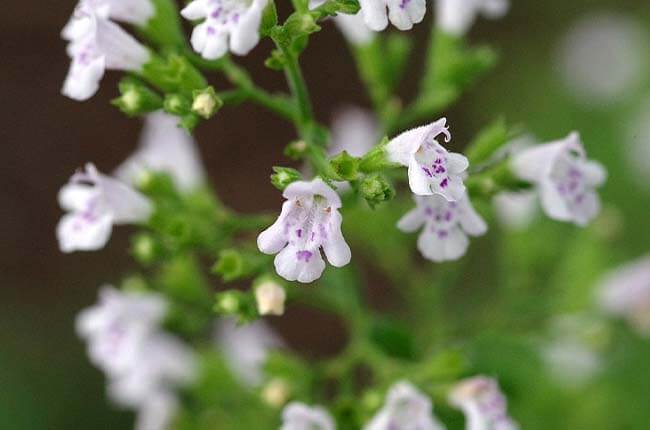
(Chihiro H, CC BY 3.0, via Wikimedia Commons)
2. Sneezeweed (Helenium autumnale)
Sneezeweed came in second as a highly favored choice among pollinators.
It has daisy-like flowers with bright petals that are wedge-shaped and have three lobes on the outside. The elevated center cone-shaped flowers are in bloom from late summer through early fall.
Bees and butterflies are especially drawn to these flowers, which is beneficial for pollinators during the later part of the growing season.
The plant can be quite tall, reaching to a mature height of 3-5 feet (0.9-1.5 meters).
It can also be identified by its lance-shaped, dark green leaves. Sneezeweed is a fantastic addition to pollinator gardens due to its resilience and low maintenance needs.
It is a perennial plant suitable for USDA zones 3-8.

(Agnieszka Kwiecien, Nova, CC BY-SA 4.0, via Wikimedia Commons)
3. Rozanne Cranesbill (Geranium ‘Rozanne’)
The Rozanne cultivar of Geranium came third in popularity amongst pollinators, offering a continuous source of sustenance for these pollinators throughout the growing season.
The violet-blue, saucer-shaped flowers feature white centers and bloom from late spring to early fall, presenting an eye-catching contrast against the plant’s foliage.
Its deeply lobed leaves display a medium to dark green hue, further enhancing the plant’s overall appearance.
The long flowering period and adaptability to various soil types make Rozanne Cranesbill a valuable addition to pollinator gardens.
The plant features a sprawling growth habit and reaches heights of 18-24 inches (45-60 cm).
It is a perennial plant that thrives in USDA zones 5-8.
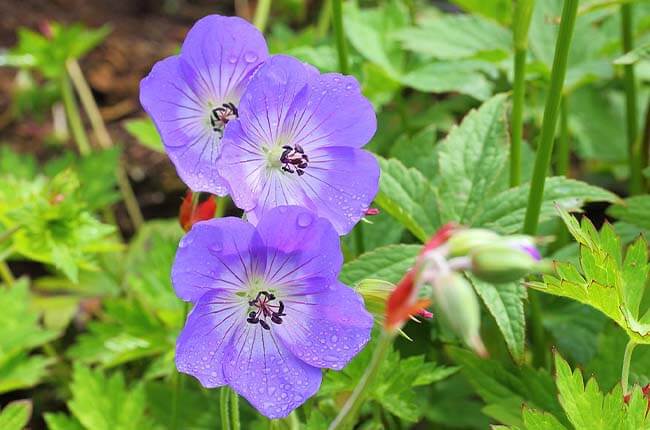
(Dominicus Johannes Bergsma, CC BY-SA 3.0, via Wikimedia Commons)
4. Sahin’s Early Flowerer Sneezeweed (Helenium ‘Sahin’s Early Flowerer’)
Sahin’s Early Flowerer Sneezeweed displays daisy-like flowers with bright yellow or orange petals and a raised central cone, blooming from early summer to early fall.
These flowers provide essential nourishment for bees, butterflies, and other pollinators, making this variety a valuable asset to pollinator-friendly gardens.
The plant has an upright growth habit and can grow up to 3-4 feet (90-120 cm) tall.
Its leaves are lance-shaped, medium green, and slightly toothed. Sahin’s Early Flowerer Sneezeweed’s hardiness and prolonged flowering period further contribute to its appeal.
It is a perennial plant suitable for USDA zones 4-8.
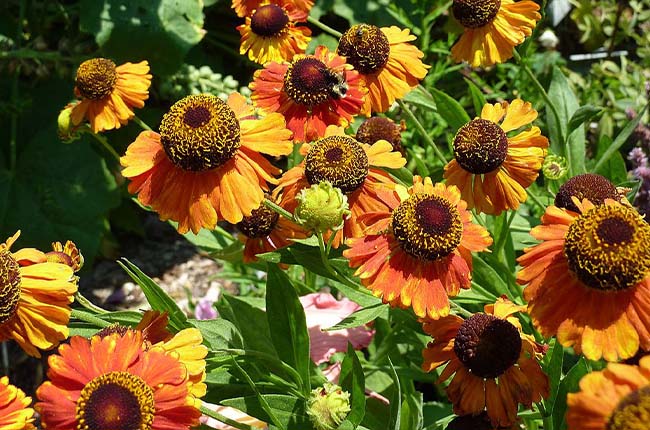
(James Steakley, CC BY-SA 4.0, via Wikimedia Commons)
5. Borage (Borago officinalis)
The star-shaped, bright blue flowers of Borage (Borago officinalis) bloom from late spring to early fall, creating a striking visual display.
Borage flowers are particularly attractive to bees, including honeybees and native bees, making this plant a valuable resource for pollinators.
The plant has an upright growth habit, reaching heights of 2-3 feet (0.6-0.9 meters).
Its leaves are large, fuzzy, and grayish-green, with a cucumber-like scent. Borage’s rapid growth, edible leaves, and flowers, as well as its ability to self-seed, make it a popular choice for pollinator gardens and edible landscapes.
It is an annual plant that grows well in USDA zones 2-11.
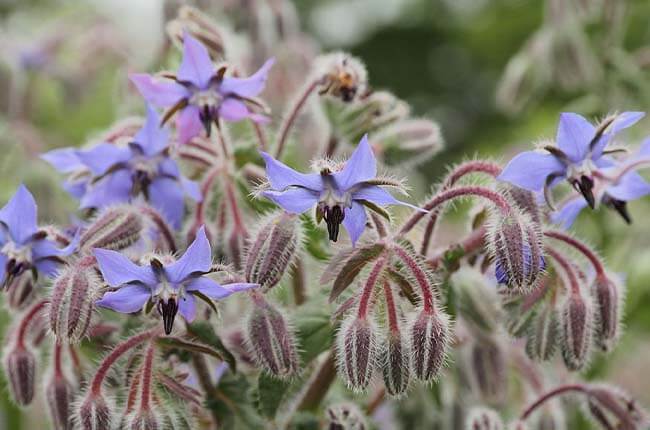
(C T Johansson, CC BY-SA 3.0, via Wikimedia Commons)
6. Oregano (Origanum vulgare)
This bushy, aromatic plant produces small tubular flowers in clusters, ranging in color from white to pale pink.
The strong, spicy scent of Oregano is an attractive feature for both culinary and ornamental purposes. The plant is a favorite among bees and butterflies, which serve as its main pollinators.
Oregano flowers in the summer.
This is a perennial herb suitable for USDA zones 5-10.

(Ivar Leidus, CC BY-SA 4.0, via Wikimedia Commons)
7. New York Aster (Aster novi-belgii)
This is a bushy, upright perennial plant that produces daisy-like flowers in shades of blue, pink, purple, and white.
Although the plant does not have a fragrance, it offers late-season blooms that are highly attractive to bees, butterflies, and other insects.
The flowering time for New York Aster is from late summer to fall.
It grows well in USDA zones 4 – 8.

(Photo by David J. Stang, CC BY-SA 4.0, via Wikimedia Commons)
8. White-flowered Oregano (Origanum vulgare white flowered)
Similar to common Oregano, the white-flowered Oregano has small tubular flowers in clusters, but they are white in color.
The aromatic, spicy scent of White-flowered Oregano is appealing for both ornamental and culinary purposes.
The plant is particularly attractive to bees and butterflies, which serve as its primary pollinators.
White-flowered Oregano typically blooms in the summer months.
This is a perennial herb that grows well in USDA zones 5-10.

(Laval University, CC BY-SA 4.0, via Wikimedia Commons)
9. Culver’s Root (Veronicastrum virginicum)
This tall, elegant plant features whorls of lance-shaped leaves and slender spikes of small, tubular flowers. It can reach 3-7 inches (8 – 18 cm) tall when in bloom.
The flowers come in shades of white or light purple, and while they don’t have a strong fragrance, they create a striking vertical element in the garden.
Culver’s Root flowers from mid to late summer, and its blooms attract bees, butterflies, and other pollinators.
This is a perennial plant suited for USDA zones 3-8.
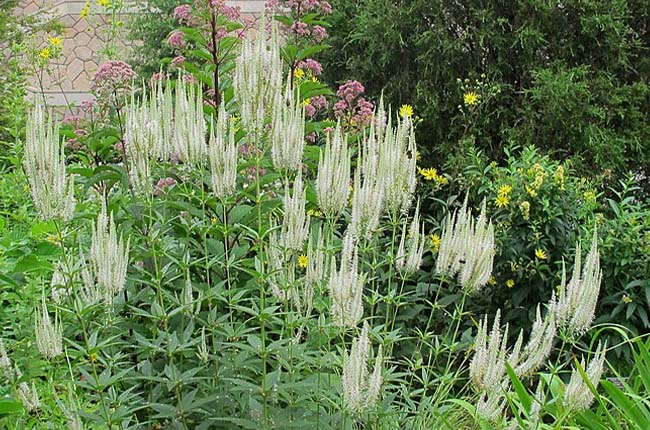
(DC Gardens, CC BY 2.0, via Wikimedia Commons)
10. Sea Holly (Eryngium planum)
This architectural plant has a basal rosette of spiny, blue-green leaves and produces thistle-like flower heads surrounded by spiky bracts.
The flowers range from steel blue to silvery-blue in color. Although they have no significant fragrance, they add a unique texture and color to the garden.
Flat Sea Holly blooms from mid to late summer and is attractive to bees, butterflies, and other pollinators.
This is a perennial plant that thrives in USDA zones 4-9.

(Ludwik Polak, CC BY-SA 4.0, via Wikimedia Commons)
11. Showy Stonecrop (Sedum spectabile)
This low-maintenance, drought-tolerant plant features succulent, blue-green leaves and large, flat clusters of star-shaped flowers.
The flowers bloom in shades of pink, red, or white with no distinct fragrance.
Showy Stonecrop flowers in late summer to early fall and provide an attractive source of late-season nectar for pollinators.
This is a perennial plant suitable for USDA zones 3-9.

(Rob Hille, Public domain, via Wikimedia Commons)
12. Edelweiss Lavender (Lavandula intermedia ‘Edelweiss’)
This compact, bushy lavender variety has gray-green, aromatic foliage and produces long, dense spikes of fragrant white flowers.
The sweet scent of the blooms is both calming and attractive to pollinators.
Edelweiss Lavender flowers from mid to late summer and is particularly appealing to bees and butterflies.
It can reach up to 24 – 36 inches (61 – 91 cm) tall.
This is a perennial plant that grows well in USDA zones 5-9.
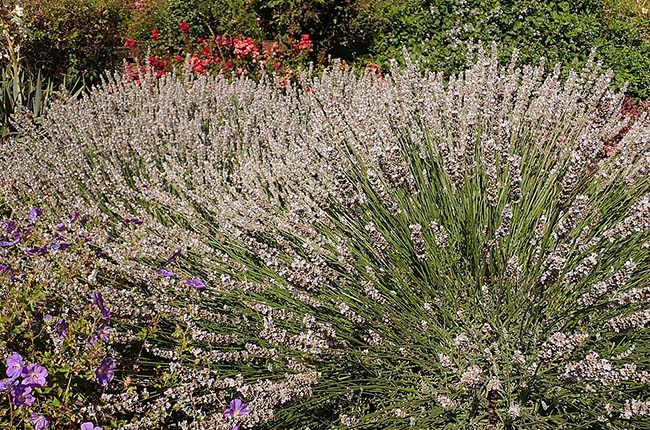
(alicyna, CC BY-SA 4.0, via Wikimedia Commons)
13. Viper’s Bugloss (Echium vulgare)
This rough, hairy plant has lance-shaped leaves and produces cylindrical spikes of bell-shaped flowers.
The flowers bloom in shades of blue or violet, often with pink or red buds, adding a striking color contrast to the garden.
While Viper’s Bugloss does not have a strong fragrance, it is a valuable nectar source for pollinators.
The plant blooms from late spring to early fall.
It is a biennial plant that can be grown in USDA zones 3-8.

(Cbaile19, CC0, via Wikimedia Commons)
14. Iranian Germander (Teucrium hircanicum)
This low-growing, bushy plant has toothed, dark green leaves and produces dozens of flowers that come in shades of purple or magenta.
Its colorful flowers and attractive foliage make it an excellent addition to garden borders, rock gardens, or mixed plantings.
It does not have a significant fragrance and typically blooms from mid-summer to early fall.
It is a perennial plant suited for USDA zones 4-8.

(Krzysztof Ziarnek, Kenraiz, CC BY-SA 4.0, via Wikimedia Commons)
15. Lamb’s Ear (Stachys byzantina)
This plant is known for its soft, fuzzy, silver-green leaves that resemble the texture of a lamb’s ear.
It produces small, pink to purple flowers on tall spikes that bloom from late spring to early summer.
The flowers attract bees and other pollinators, while the unique foliage adds texture and interest to garden borders or groundcover plantings.
This is a perennial plant that grows in USDA zones 4 – 9.
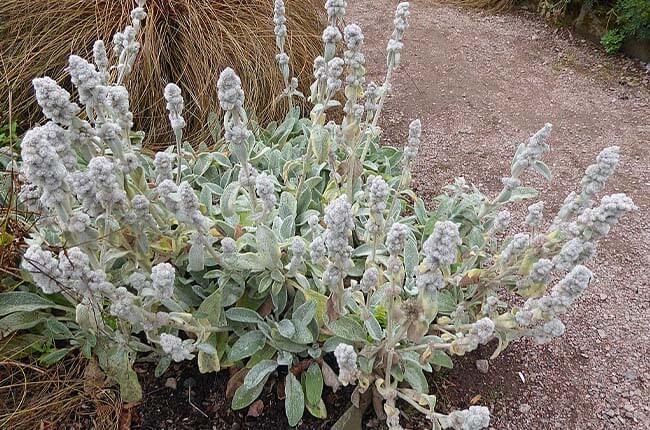
(Syrio, CC BY-SA 4.0, via Wikimedia Commons)
16. Greater Knapweed (Centaurea scabiosa)
This wildflower features large, thistle-like, purple to pink flowers with a distinctive shape, resembling a pincushion.
The flowers bloom from early to late summer.
The plant’s sturdy stems and striking flower heads make it an excellent choice for naturalistic gardens, meadows, or wildlife gardens.
This is a perennial plant that grows in USDA zones 4 – 8.
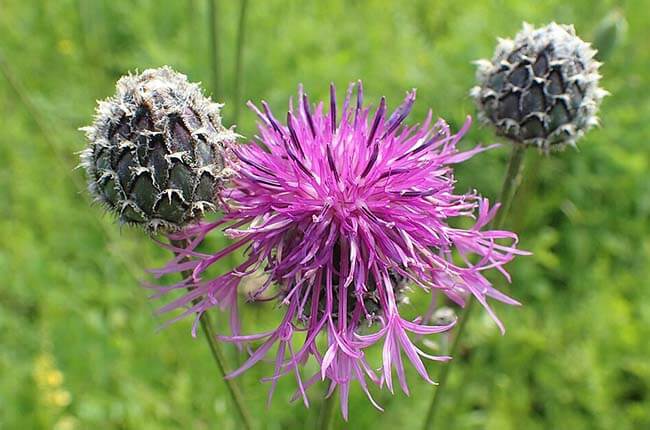
(Krzysztof Ziarnek, Kenraiz, CC BY-SA 4.0, via Wikimedia Commons)
17. Hyssop (Hyssopus officinalis)
Hyssop produces spikes of vibrant blue, purple, or pink flowers from mid-summer to early fall.
The flowers are tubular and highly fragrant, attracting bees, butterflies, and hummingbirds.
Often used in herb gardens or borders, hyssop’s aromatic foliage and flowers provide both visual and sensory appeal, as well as culinary and medicinal uses.
This is a perennial herb that grows in USDA zones 4 – 9.
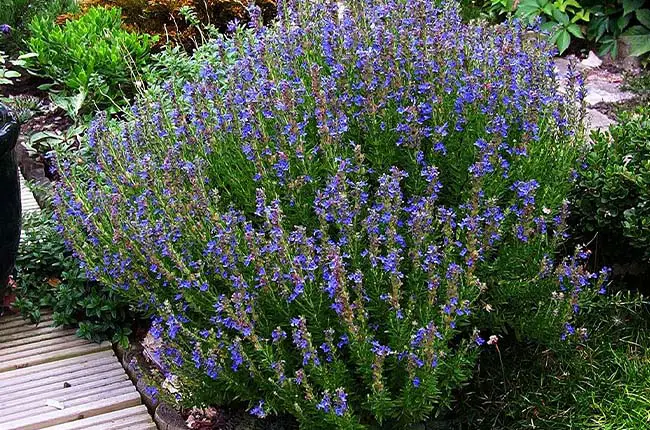
(peganum from Small Dole, England, CC BY-SA 2.0, via Wikimedia Commons)
18. Tall Verbena (Verbena bonariensis)
This is known for its tall, slender stems topped with clusters of small, lavender-purple flowers.
The flowers bloom from summer to frost and are highly attractive to butterflies, bees, and other pollinators.
The plant’s airy, see-through quality makes it an excellent choice for mixed borders, meadows, or wildlife gardens, where it adds height and movement.
This is a perennial plant that grows in USDA zones 7 – 11.
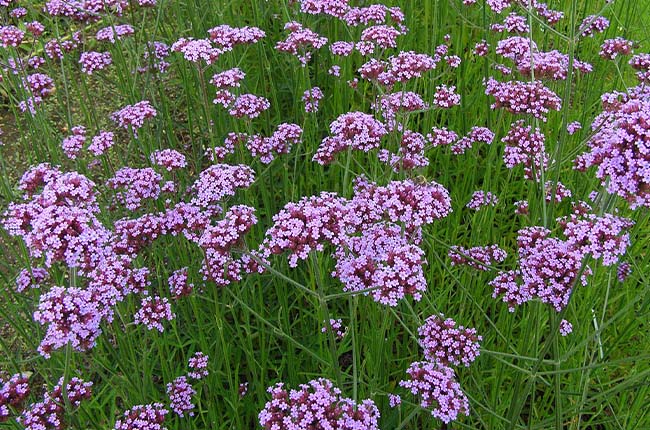
(frank wouters, CC BY 2.0, via Wikimedia Commons)
19. Spiked Speedwell (Veronica spicata)
Spiked Speedwell produces spikes of small, tubular flowers in shades of blue, purple, pink, or white from early to late summer.
The plant’s compact growth habit and colorful flower spikes make it a popular choice for borders, rock gardens, or cottage gardens.
This is a perennial plant that grows in zones 3 – 8.
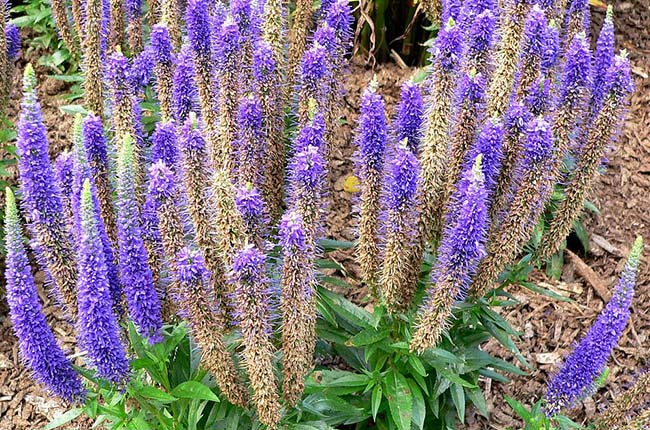
(Stan Shebs, CC BY-SA 3.0, via Wikimedia Commons)
20. Hemp Agrimony (Eupatorium cannabinum)
This is a tall, bushy plant with clusters of small, pinkish-purple flowers that bloom from mid-summer to early fall.
The plant’s attractive, divided foliage adds texture to garden borders or wildlife gardens, where it can provide a valuable source of nectar for pollinators.
This is a perennial plant that grows in zones 4 – 8.

(Hladac, CC BY-SA 4.0, via Wikimedia Commons)
21. Dwarf Catmint (Nepeta racemosa)
This is a compact plant that produces spikes of small, lavender-blue flowers from late spring to early fall. The flowers are highly attractive to bees, butterflies, and other pollinators, while the fragrant, gray-green foliage is resistant to deer and rabbits.
Dwarf Catmint adds color and fragrance throughout the season.
This is a perennial plant that grows in zones 4 – 8.
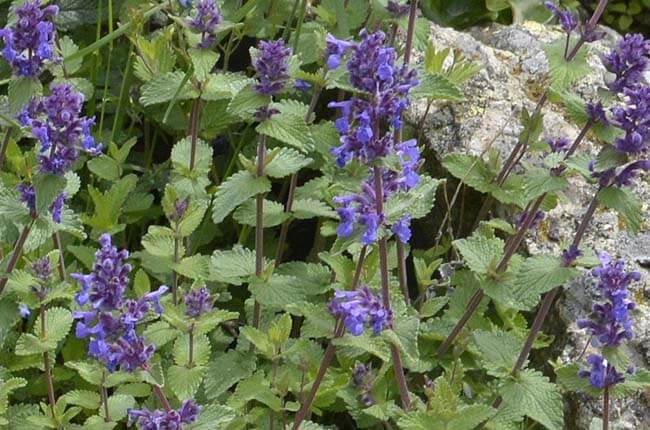
(CristianNX, CC BY-SA 4.0, via Wikimedia Commons)
22. Sawyers Lavender (Lavandula x chaytoriae ‘Sawyers’)
This is a perennial plant known for its striking, silver-gray foliage and long, dark purple flower spikes.
Blooming from early to mid-summer, the flowers emit a strong, pleasant fragrance that attracts bees, butterflies, and other pollinators.
This variety of lavender is prized for its ornamental appeal, making it a popular choice for borders, herb gardens, and rock gardens, where it adds a touch of elegance and fragrance.
23. Viper’s Bugloss (Echium vulgare ‘Blue Bedder’)
This plant features eye-catching spikes of bright blue flowers with pinkish-red stamens.
Blooming from late spring to early summer, the plant’s architectural form and striking color make it a standout in borders, meadows, or wildlife gardens.
This is a biennial plant that grows in USDA zones 3 – 8.
24. Moorheim Beauty Sneezeweed (Helenium ‘Moorheim Beauty’)
This is a perennial plant that produces vibrant, daisy-like flowers with deep red petals surrounding a prominent, dark brown central cone.
Blooming from mid-summer to early fall, this variety of sneezeweed is celebrated for its long-lasting, rich color and sturdy stems, making it a stunning addition to perennial borders, cottage gardens, or meadows.
This is a perennial plant that grows in USDA zones 4- 8.
25. Giant Sea Holly (Eryngium giganteum)
This plant is known for its large, thistle-like, silvery-blue flowers surrounded by a dramatic collar of spiny, silvery bracts.
The flowers bloom from mid to late summer, with a unique and striking color.
This is a biennial plant that grows in USDA zone 5-9.
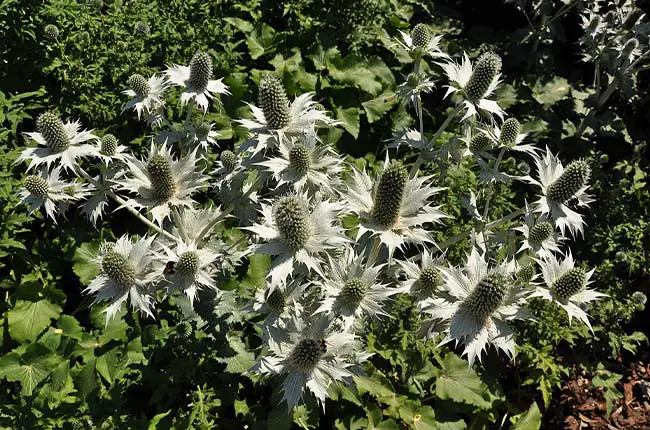
(Bob Collowan, CC BY-SA 3.0, via Wikimedia Commons)
26. Orange Coneflower (Rudbeckia fulgida)
Orange Coneflower features bright, daisy-like flowers with golden-yellow petals surrounding a dark brown central cone and blooms from mid-summer to early fall.
The plant’s long-lasting blooms, sturdy stems, and low-maintenance nature make it a popular choice for perennial borders, meadows, or wildlife gardens.
This is a perennial plant that grows in USDA zones 4-9.
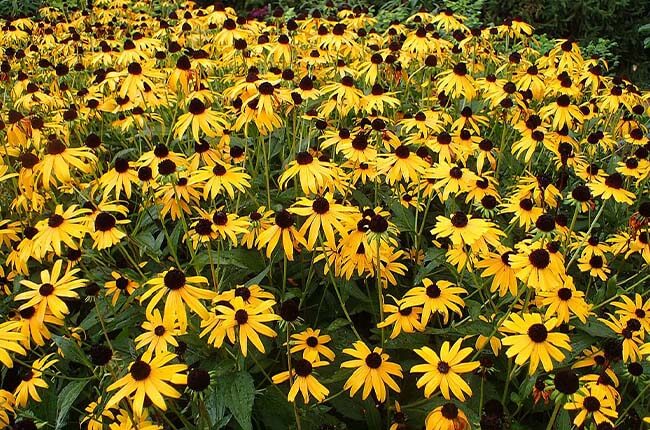
(Krzysztof Ziarnek, Kenraiz, CC BY-SA 4.0, via Wikimedia Commons)
27. Pincushion flower (Scabiosa columbaria)
Dove Pincushion produces delicate, pincushion-like flowers in shades of lavender-blue, pink, or white that bloom from late spring to early fall.
With its compact growth habit and long-lasting blooms, Dove Pincushion is a lovely addition to borders, rock gardens, or cottage gardens, where it adds a touch of soft color and charm.
This is a perennial plant that grows in USDA zone 4 – 9.

(Père Igor, CC BY-SA 3.0, via Wikimedia Commons)
28. Golden Marguerite (Anthemis tinctoria)
Golden Marguerite is known for its bright, daisy-like flowers with golden-yellow petals surrounding a yellow central disc.
The flowers bloom from early to late summer and emit a pleasant, chamomile-like fragrance that attracts pollinators.
This low-maintenance plant is highly prized for its long-lasting blooms and vibrant color.
This is a perennial plant that grows in USDA zone 4 – 9.

(Krzysztof Ziarnek, Kenraiz, CC BY-SA 4.0, via Wikimedia Commons)
29. Pot Marigold (Calendula officinalis)
Pot Marigold has vibrant, daisy-like flowers that range in color from bright yellow to deep orange with a mild, honey-like fragrance and bloom from late spring to early fall.
Pot Marigold is not only valued for their ornamental appeal but also for its edible petals and medicinal uses, making them a popular choice for herb gardens, borders, or containers.
This is an annual plant that grows in USDA zones 2 – 11.

(Flominator, CC BY-SA 3.0, via Wikimedia Commons)
30. Devil’s Bit Scabious (Succisa pratensis)
Devil’s Bit Scabious produces delicate, pincushion-like flowers in shades of blue, purple, or sometimes white that bloom from late summer to early fall.
With its graceful, upright stems and charming flowers, Devil’s Bit Scabious is a beautiful addition to meadows, cottage gardens, or wildlife gardens.
This is a perennial plant that grows in USDA zones 4 – 8.

(Blue heron, CC BY-SA 3.0, via Wikimedia Commons)
31. Pot Marjoram (Origanum onites)
This is a perennial plant that grows in USDA zone 8 -10.
Pot Marjoram features clusters of small, tubular, pale pink to purple flowers that bloom from mid to late summer.
The flowers emit a pleasant, oregano-like fragrance that attracts bees, butterflies, and other pollinators.
Often used as a culinary herb, Pot Marjoram is also valued for its ornamental appeal, making it a versatile addition to herb gardens, borders, or Mediterranean-style landscapes.
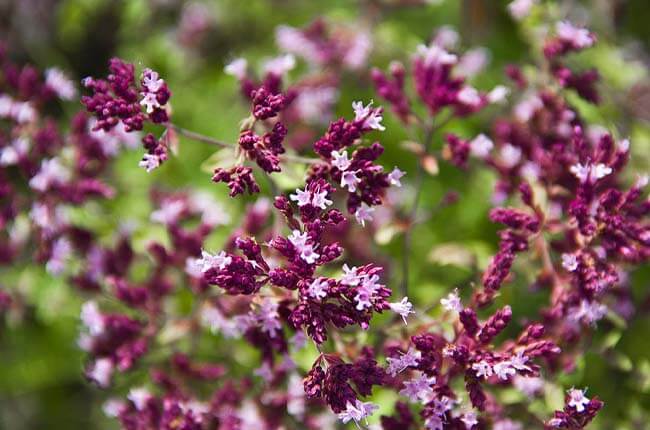
(Sunsight, CC BY-SA 3.0, via Wikimedia Commons)
32. Globe Thistle (Echinops bannaticus ‘Star Frost’)
Blooming from mid to late summer, Star Frost Globe Thistle is known for its striking, globe-shaped flower heads composed of numerous tiny, white, star-shaped flowers.
This is a perennial plant that grows in USDA zone 4 – 9.
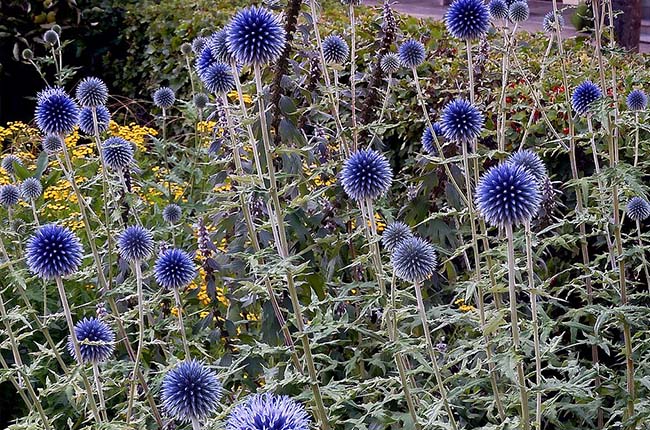
(Jonn Leffmann, CC BY 3.0, via Wikimedia Commons)
33. Hollyhock Mallow (Malva alcea)
This is a perennial plant that grows in USDA zone 4-8.
Hollyhock Mallow has saucer-shaped flowers in shades of pink to lavender, often featuring darker veins.
Blooming from early to late summer, Hollyhock Mallow is a charming addition to cottage gardens, mixed borders, or wildflower meadows, where its showy blooms add color and vertical interest.

(Benjamin Zwittnig, CC BY 2.5 SI, via Wikimedia Commons)
34. Canada Goldenrod (Solidago canadensis)
Canada Goldenrod produces tall, slender spikes of small, bright yellow flowers that bloom from late summer to early fall.
This native plant is known for its hardiness and ability to thrive in various conditions, making it a valuable addition to natural landscapes, meadows, and wildlife gardens.
This is a perennial plant that grows in USDA zones 3-9.
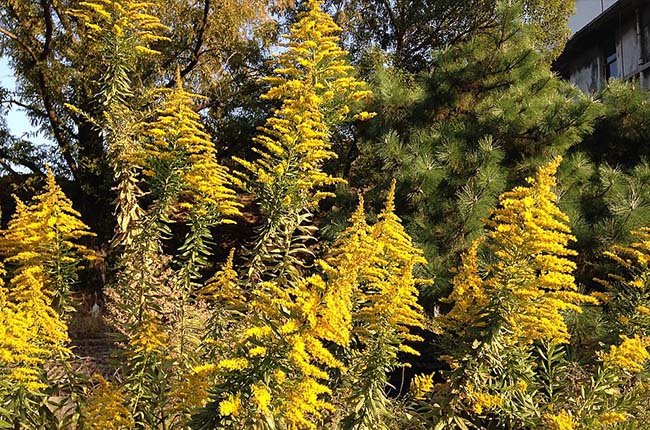
(そらみみ (Soramimi), CC BY-SA 4.0, via Wikimedia Commons)
35. Macedonian Scabious (Knautia macedonica)
This is a perennial plant that thrives in USDA zones 5-9.
The flowers of this plant are unique, boasting deep wine-red, pincushion-like blooms that appear from early summer through the fall. The fragrant flowers are rich in nectar, attracting a wide range of pollinators such as bees, butterflies, and hummingbirds.
Macedonian Scabious is an excellent choice for gardeners looking to support a diverse pollinator population.
The leaves are deeply lobed, featuring a dark green color with a slightly fuzzy texture.
Its growth habit is clump-forming, reaching heights of 18-24 inches (45-60 cm).
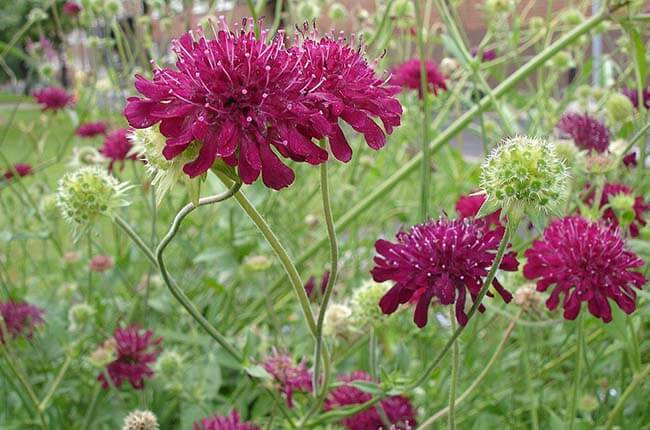
(Epibase, CC BY 3.0, via Wikimedia Commons)
36. Grosso Lavender (Lavandula x intermedia ‘Grosso’)
This is a highly aromatic perennial plant that flourishes in USDA zones 5-9.
This lavender variety can grow up to 36 inches (91 cm) tall and features a mounded growth habit. Its linear, grayish-green leaves contrast beautifully with the vibrant purple flower spikes.
Blooming from late spring to late summer, the flowers emit a strong, pleasant fragrance that is irresistible to bees, butterflies, and other pollinators.
Its hardiness, drought tolerance, and low maintenance requirements make it a valuable addition to pollinator gardens.
37. Anise Hyssop (Agastache foeniculum)
This plant typically reaches a height of 2-4 feet (60-120 cm) and features a bushy, upright growth habit.
The leaves are lance-shaped and bright green, exuding a sweet anise scent when crushed.
Tubular, lavender-blue flowers form dense spikes, blooming from midsummer to early fall.
Its nectar-rich blooms, long flowering period, and delightful fragrance make Anise Hyssop a popular choice for pollinator gardens.
This is a perennial plant suitable for USDA zones 4-10.

(cultivar413 from Fallbrook, California, CC BY 2.0, via Wikimedia Commons)
38. Lacy Phacelia (Phacelia tanacetifolia)
Lacy Phacelia has a bushy, sprawling habit that grows quickly to a height of 1-3 feet (0.3-0.9 meters).
The fern-like leaves are deeply divided, giving the plant a delicate, lacy appearance.
The flowers are tubular, violet-blue, and arranged in scorpion-tail-like clusters, blooming from late spring to early summer.
This is an annual plant that thrives in USDA zones 2-11.
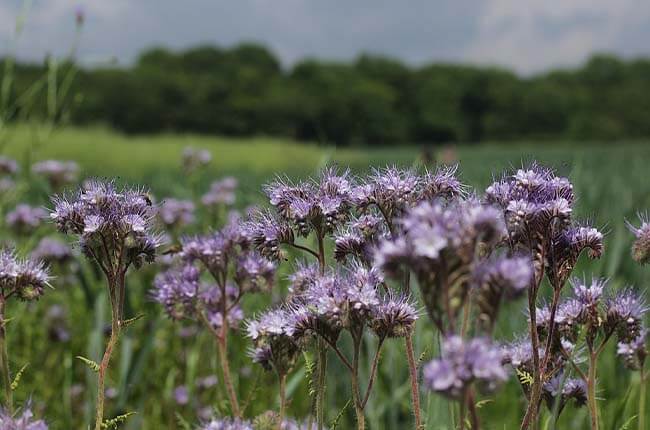
(Björn S…, CC BY-SA 2.0, via Wikimedia Commons)
39. Field Scabious (Knautia arvensis)
Field Scabiouis features an upright growth habit and can reach heights of 1-3 feet (0.3-0.9 meters).
The leaves are lance-shaped and medium green, arranged in a basal rosette.
The flowers are pale lilac to lavender-blue and form a domed, pincushion-like shape, blooming from early summer to early fall.
The nectar-rich flowers of Field Scabious are popular among bees, butterflies, and other pollinators, making it a valuable addition to any pollinator-friendly garden.
This is a perennial plant suitable for USDA zones 4-8.

(Matt Lavin, CC BY-SA 2.0, via Wikimedia Commons)
40. Black Knapweed (Centaurea nigra)
Black Knapweed grows to a height of 1-3 feet (0.3-0.9 meters) with a bushy, clump-forming habit with leaves that are lance-shaped, grayish-green, and slightly hairy.
The thistle-like flowers are deep purple to almost black, blooming from early summer to late autumn. These flowers provide a valuable nectar source for pollinators such as bees, butterflies, and hoverflies.
Black Knapweed’s hardiness and low maintenance requirements make it an excellent choice for gardeners looking to create a pollinator-friendly environment.
This is a perennial plant that flourishes in USDA zones 3-9.

(Ryan Hodnett, CC BY-SA 4.0, via Wikimedia Commons)
41. Yellow Sweet Clover (Melilotus officinalis)
Reaching up to 3-6 feet (0.9-1.8 meters) tall, the Yellow Sweet Clover features an upright and branching growth habit.
Its leaves are trifoliate, with oblong leaflets that have serrated edges.
The small, yellow flowers form elongated clusters, blooming from late spring to early summer. These flowers emit a sweet, honey-like fragrance that attracts various pollinators such as bees, butterflies, and other beneficial insects.
Its ability to fix nitrogen in the soil, in addition to its attractiveness to pollinators, makes it a valuable plant for both gardens and agricultural fields.
This is a biennial plant that flourishes in USDA zones 3-9.
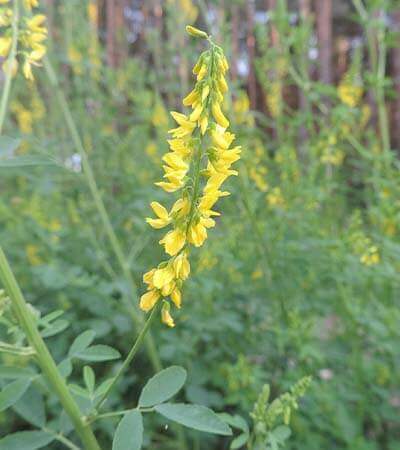
(Krzysztof Ziarnek, Kenraiz, CC BY-SA 4.0, via Wikimedia Commons)
42. Bowles Mauve Wallflower (Erysimum bicolor ‘Bowles Mauve’)
Bowles Mauve Wallflower features an upright, bushy growth habit and reaches heights of 18-24 inches (45-60 cm).
Its narrow, lance-shaped leaves are evergreen and have a grayish-green hue.
The mauve-purple flowers bloom on elongated racemes from early spring through fall with a sweet fragrance.
Its prolonged flowering period and adaptability to various soil types make it a valuable addition to pollinator gardens.
This is a perennial plant that thrives in USDA zones 6-9.
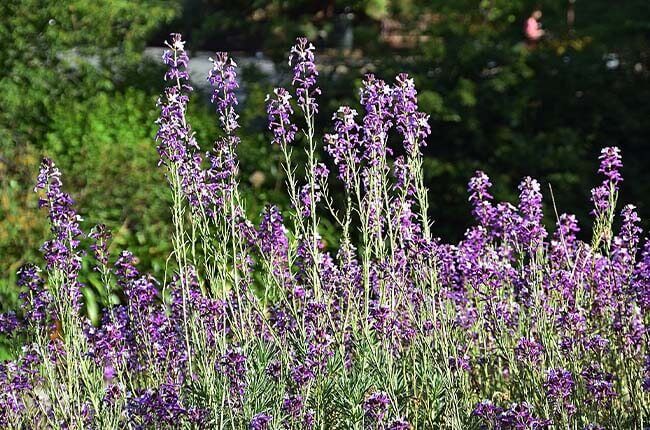
(Krzysztof Golik, CC BY-SA 4.0, via Wikimedia Commons)
43. Annual Clary (Salvia viridis)
Annual Clary features an upright growth habit and can grow up to 18-24 inches (45-60 cm) tall.
The leaves are broadly ovate, with a textured surface and grayish-green color.
Its unique flowers are actually colorful bracts, which can be blue, pink, or white, surrounding small, inconspicuous flowers, blooming from late spring to early fall.
Its striking appearance and low maintenance requirements make it an excellent choice for attracting pollinators in any garden setting.
This is an annual plant suitable for USDA zones 2-11.
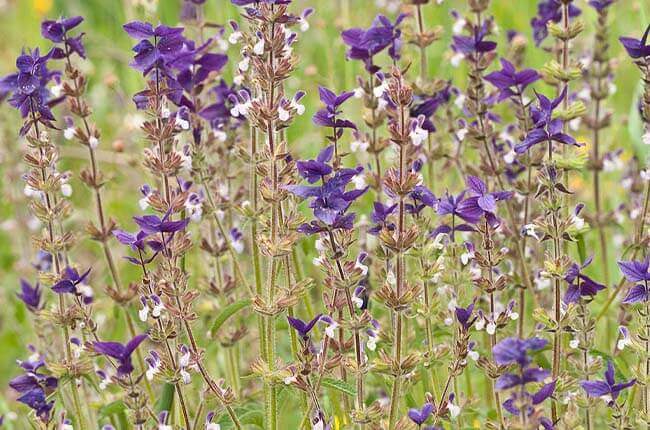
(Zeynel Cebeci, CC BY-SA 4.0, via Wikimedia Commons)
44. Hedge Woundwort (Stachys sylvatica)
Hedge Woundwort is an upright plant, reaching heights of 24-36 inches (60-90 cm) with heart-shaped, leaves and toothed edges, and a dark green color.
The tubular flowers are reddish-purple, arranged in dense, terminal spikes, and bloom from early summer to early fall.
Its shade tolerance and ability to grow in a variety of soil types make it a versatile plant for pollinator gardens.
This is a perennial plant that grows well in USDA zones 5-9.
45. Blue Boa Anise Hyssop (Agastache foeniculum ‘Blue Boa’)
Blue Boa Anise Hyssop can grow quite tall, reaching a mature height of 2-3 feet (60 – 90 cm).
The leaves are lance-shaped, bright green, and emit a sweet anise scent when crushed.
The tubular, violet-blue flowers bloom in dense spikes from early summer to early fall.
This is a perennial plant suitable for USDA zones 5-10.
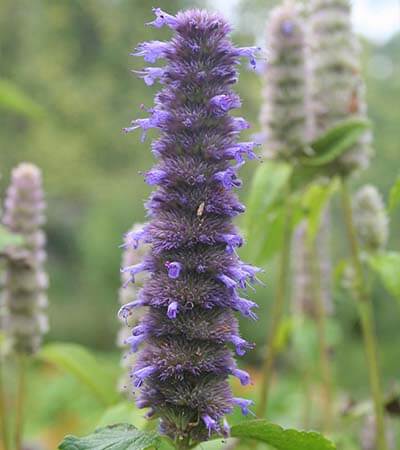
(Pmau, CC BY-SA 4.0, via Wikimedia Commons)
46. White Swan Coneflower (Echinacea purpurea ‘White Swan’)
It features an upright growth habit and reaches heights of 24-36 inches (60-90 cm).
The dark green leaves have a slightly rough texture.
Its large, daisy-like flowers have white petals surrounding a prominent central cone, blooming from early summer to early fall.
Its hardiness, low maintenance requirements, and elegant appearance make it a valuable addition to pollinator gardens.
This is a perennial plant that thrives in USDA zones 3-8.
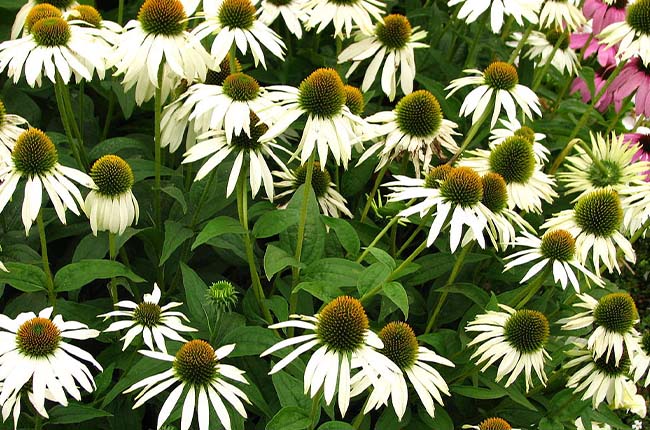
(Kor!An (Корзун Андрей), CC BY-SA 4.0, via Wikimedia Commons)
47. Showy Black-eyed Susan (Rudbeckia speciosa)
The Showy Black-eyed Susan features an upright growth habit, reaching heights of 24-36 inches (60-90 cm).
Its large, daisy-like flowers have vibrant yellow petals surrounding a dark brown, raised central cone, blooming from midsummer to early fall.
This is a perennial plant suitable for USDA zones 3-9.
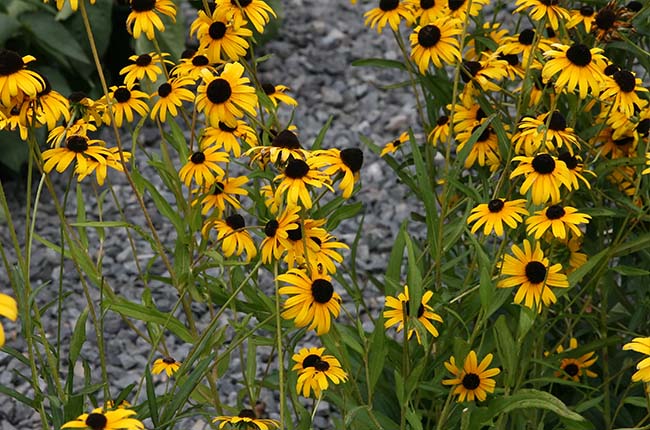
(Photo by David J. Stang, CC BY-SA 4.0, via Wikimedia Commons)
48. Catmint (Nepeta mussinii)
The Catmint features a mounding growth habit and reaches heights of 12-18 inches (30-45 cm).
Its small, grayish-green leaves are aromatic and have a slightly fuzzy texture.
The tubular, lavender-blue flowers bloom in dense spikes from late spring to early fall and are particularly attractive to bees, butterflies, and other pollinators, providing a valuable nectar source throughout the growing season.
Its drought tolerance, low maintenance requirements, and long blooming period make it a popular choice for pollinator gardens.
This is a perennial plant that thrives in USDA zones 4-8.
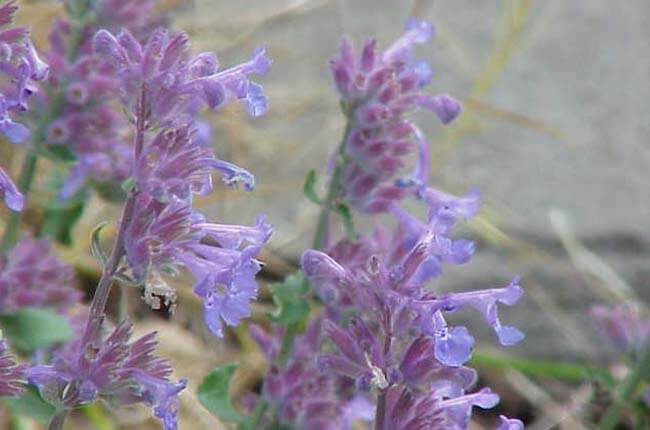
(Kurt Stüber, CC BY-SA 3.0, via Wikimedia Commons)
49. Munstead Lavender (Lavandula angustifolia ‘Munstead’)
The Munstead Lavender features a compact, mounding growth habit and reaches heights of 12-18 inches (30-45 cm).
The narrow, linear leaves are grayish-green and emit a pleasant fragrance when touched.
Its dense, lavender-blue flower spikes bloom from late spring to early summer.
It is a popular choice for pollinator gardens due to its hardiness, drought tolerance, and low maintenance requirements, in addition to its lovely fragrance and attractive appearance.
This is a perennial plant suitable for USDA zones 5-9.
50. Purple Coneflower (Echinacea purpurea)
The Purple Coneflower showcases large, daisy-like flowers with slightly drooping, purple-pink petals surrounding a raised, dark orange central cone. It blooms from early summer to late summer, providing a vital source of food for bees, butterflies, and other pollinators.
The plant has an upright growth habit, reaching heights of 2-4 feet (0.6-1.2 meters).
Its leaves are lance-shaped, coarse, and dark green in color.
Its hardiness, low maintenance requirements, and medicinal uses make it an excellent addition to pollinator gardens and landscapes.
It is a perennial plant that grows well in USDA zones 3-9.

(Jmeeter, Public domain, via Wikimedia Commons)
51. Woodland sage (Salvia nemorosa)
The Woodland Sage features dense spikes of tubular, violet-blue flowers that bloom from late spring to early summer.
Its leaves are narrow, wrinkled, and grayish-green in color.
The long flowering period, drought tolerance, and ability to thrive in various soil types make Woodland Sage a popular choice for pollinator-friendly gardens.
The plant has a mounding growth habit and can reach heights of 18-24 inches (45-60 cm).
It is a perennial plant suitable for USDA zones 4-9.
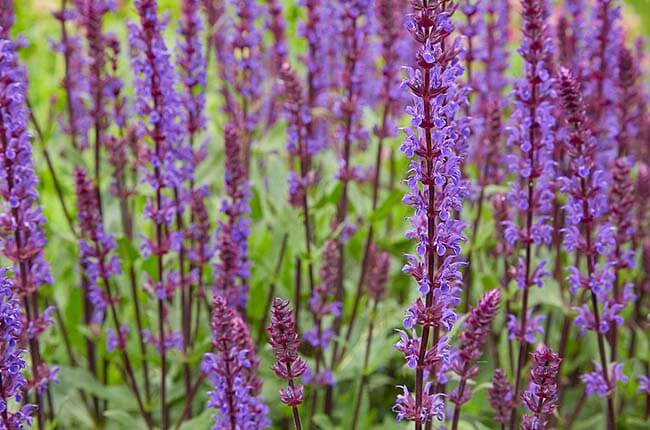
(DoF CC-BY-X, CC BY-SA 4.0, via Wikimedia Commons)
Which is the best flower to attract pollinators?
According to the study of 111 flower species (Rollings & Goulson 2019), the most popular plants amongst the insects were Lesser Calamint (Calamintha nepeta), Autumn Sneezeweed (Helenium autumnale), and Geranium ‘Rozanne’ (a popular Geranium cultivar).
Native plants generally attract a much wider variety of insects, but the difference is not big. Also, there is not really a difference if the plants are annuals, biennials, or perennials.
Also, different pollinators do have a preference for specific plants. But, the reason behind their flower preference is still unknown.
For example, according to the study, some plants were found to attract a broad range of pollinators but others attracted only a few species.
Another example is the daisy-like New York Aster (Aster novi belgii) which were visited mostly by honeybees or bumblebees, but the Golden Chamomile (Anthemis tinctoria), which also have daisy-like flowers, did not attract a single honeybee or bumblebee but was popular with solitary bees, hoverflies and other pollinators.
So, what does this mean?
The best approach is to grow a variety of flowers of different species and different colors to attract a variety of pollinators.
And, one of the best ways to plant flowers in your yard or garden is to make seed bombs.
Happy gardening!
Related
DIY Seed Bombs With Clay, Flour or Paper (Easy)
Planting Seed Bombs: 11 Common Questions
Reference
Rollings, R., & Goulson, D. (2019). Quantifying the attractiveness of garden flowers for pollinators. Journal of Insect Conservation. https://doi.org/10.1007/s10841-019- 00177-3
- Keiki Paste vs Rooting Hormone:What’s the difference? - February 4, 2024
- Top 10 Orchid Fertilizers: A Comprehensive Review (2024) - February 2, 2024
- Top 8 Soil Inoculants For Stronger Plants (2024) - February 1, 2024

